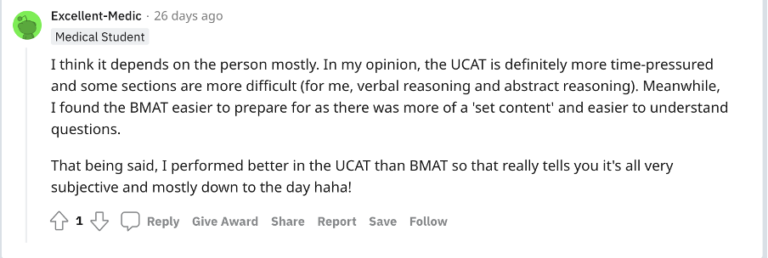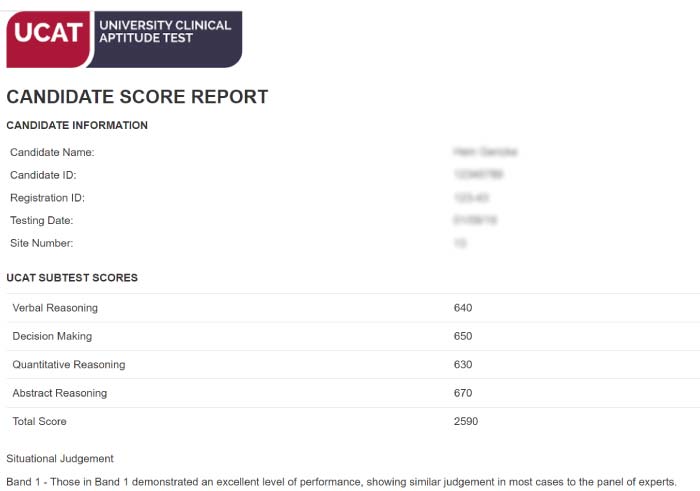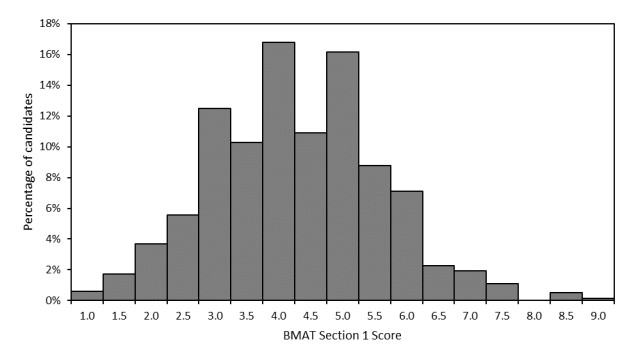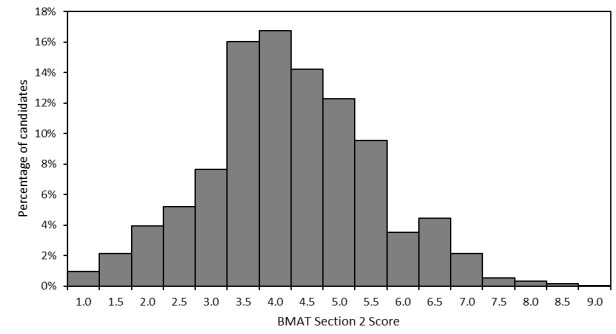When applying to Medical School, you will come across countless mentions of the UCAT and the BMAT.
These two admission tests are essential components of your Medicine (or Dentistry) application, but what are they, and what are the differences between them?
Understanding them means you can prepare effectively for them and set yourself up to score highly.
We will go over everything about the UCAT and the BMAT.
What is the UCAT and the BMAT?
The University Clinical Aptitude Test (UCAT) is a computer-based admissions test used by a consortium of UK universities to help select applicants for their Medical and Dental degree programmes.
It is used in collaboration with other admissions processes such as the UCAS application and academic qualifications.
Then you have the BMAT.
The BioMedical Admissions Test (BMAT) tests your ability to apply scientific and mathematical knowledge, as well as problem solving, critical thinking and written communication skills that are essential to university-level study. Unlike the UCAT, the BMAT is done on pen and paper.
Both of these should be used as your opportunity to stand out from other applicants and demonstrate your aptitude for a demanding programme of study.
UCAT vs BMAT: The Exams
One of the major differences between the two is the format of them.
Though both utilise multiple-choice questions, this is the entirety of the UCAT, whereas the BMAT has the addition of an essay question as well. Additionally, the UCAT is made up of five sections, whereas the BMAT is just three.
The key differences between them, are:
| UCAT | BMAT | |
|---|---|---|
| Length | Two hours | Two hours |
| Format | Online | Pen and paper |
| Questions | Multiple choice | Multiple choice and essay |
| Amount of questions | 228 | 60 |
| Sections | Five | Three |
| Focus | Aptitude | Knowledge |
| Dates | July to September | November |
| Results | Immediately | 25th November 2022 |
Taking a closure look at the two will make it to easier to understand what makes them so different.
The UCAT
The UCAT is sat by around 30,000 students each year applying to Medicine and Dentistry.
It is largely more of an aptitude test than an academic test, and it tests abilities such as problem-solving and critical thinking.
The UCAT is made up of five sections: Verbal Reasoning, Decision Making, Quantitative Reasoning, Abstract Reasoning, and Situational Judgement.
Exam changes over the years
| Year | Change |
|---|---|
| 2019 | Prior to 2019, the test was known as the UKCAT, UK Clinical Aptitude Test, but was renamed to the UCAT, University Clinical Aptitude Test, to reflect the fact Medical Schools in other countries have implemented it as part of their requirements and application process. |
| 2022 | The Quantitative Reasoning section had an additional minute allocated to it with the number of questions remaining the same. The Abstract Reasoning section was reduced from 55 to 50 questions, with a minute less allocated in line with this change. The biggest change came in the Situational Judgement section with the number of questions going from 69 to 66 but the amount of time remained the same. Additionally, a new question format was introduced but on the whole was not that different to the format already used. |
The sections of the UCAT
| Section | What You Need to Know |
|---|---|
| Verbal Reasoning | The aim of the Verbal Reasoning section is to assess your ability to read and interpret qualitative data, and then draw conclusions based on what you’ve read. You’ll be required to read a short 200–300-word passage and then have to decide the correct assumption based on the text and answer true/false questions. You have 21 minutes to answer 44 questions in this section. |
| Decision Making | In the Decision-Making section, the aim is to assess your ability to apply logic to make decisions or reach a conclusion, analyse statistical data and evaluate arguments. Each question involves a passage of text or set of data, with questions that will present arguments to you. Using this information, you have to decide whether the statements given are valid and logical conclusions or not. This is the least time-pressured section of the test, with 31 minutes to answer 29 questions, so take advantage of this and use your time wisely. |
| Quantitative Reasoning | Quantitative Reasoning is the third section of the UCAT and is designed to assess how you use numbers to solve problems. This section tests your ability to apply simple mathematical skills to certain contexts. It assumes you have a good GCSE standard of maths and doesn’t include any content above this level. These questions assess your ability to interpret numerical data and pick out the important parts of it. You have 25 minutes to answer 36 questions meaning you have around 40 seconds per question. |
| Abstract Reasoning | The aim of Abstract Reasoning is to assess your ability to identify patterns in sets of shapes and decide which shape comes next in the sequence. This probably sounds very straightforward, but the test likes to try and throw you off by including some irrelevant data that may lead you to make the wrong decision. With this section, remember that just because you have found a pattern in the shapes, it may not necessarily be the right one. This is often the section people struggle with the most. And with 12 minutes to answer 50 questions, that means you have 14 seconds per question. |
| Situational Judgement | The Situational Judgement section is entirely different from the rest of the test, as it assesses your ability to understand situations and determine the most appropriate action for each. As with all the other sections, SJT doesn’t require any previous academic knowledge – it is essentially testing your common sense. According to the UCAT website, the test assesses several qualities that are essential in a clinical environment: For this final section, you have 26 minutes to answer 69 questions. |
How can I explain the UCAT to my students?
If you are a teacher wanting to help your students prepare for the UCAT but are unsure how to explain it to them, here at 6med we have a countless guides and information covering everything you need to know for the UCAT.
They can also sign up for a free account of our UCAT.Ninja platform.
Another useful site is of course the UCAT Consortium itself.
The site is comprehensive and contains practice papers that they can use in their preparations.
Understanding the five sections means that you would be able to assist them in practice and guide them in their preparations.
Students can also use our UCAT resources to prepare for the test.
The applicant decides when to take the test, meaning they can prepare to their own timeline.


The BMAT
Around 15,000 students sit the BMAT, half of that which sit the UCAT.
One of the most significant differences between the two is that the BMAT uses more genuine academic knowledge and problem-solving skills compared to the UCAT.
There are three sections that make up the BMAT: Thinking Skills, Scientific Knowledge, and Writing Task.
Exam changes over the years
| Year | Changes |
|---|---|
| 2009 | Section 2 of the BMAT, underwent a specification change in 2009 so any past papers previous to this are less indicative of the actual BMAT. |
| 2020 | In 2020 there was a change made to Section 1. The section was changed from ‘Aptitude and Skills’ to ‘Thinking Skills’, this change also brought with it three less questions for the same amount of time. The long text ‘stem’ questions and several related questions were removed. ‘Matching Arguments’ and ‘Applying Principles’ questions were introduced. If you use any past papers from before 2020, they will have this old style of question and the three additional questions so keep this in mind. You can either remove them or keep them in for the extra challenge. Additionally, due to Covid-19 the exam was changed to being computer based. |
| 2022 | The BMAT was reverted back to being a pen-and-paper test. |
The sections of the BMAT
| Section | What You Need to Know |
|---|---|
| Section 1 | Section 1 broadly covers two types of questions Critical Thinking and Problem Solving. Critical Thinking questions are fairly straightforward; you get a paragraph around 4-5 lines long and a multiple-choice question based on that paragraph. Problem Solving is trickier to prepare for. Our advice, though, is to be good at fractions as so many of the BMAT questions require students to be proficient at calculating them quickly. Overall, you will have 60 minutes to answer 32 questions. |
| Section 2 | The questions in Section 2 cover four major subjects: Mathematics, Biology, Chemistry and Physics. There are 27 questions to answer, seven for each of the sciences and 6 for mathematics. The questions require a set syllabus of GCSE-level science knowledge, but they often require quite sophisticated applications of knowledge under intense time pressure. You have just 30 minutes for this section, so be wary of the time pressure you will be under. |
| Section 3 | This is where the BMAT really differs from the UCAT. Section 3 tests your ability to develop and organise ideas and to communicate them concisely and effectively in writing. The ever-dreaded essay section assesses your ability to formulate your own arguments and communicate your ideas clearly, which is crucial for a successful academic or clinical career. You will be presented with three questions, of which you answer just one of. You have just 30 minutes to answer this section, so use your time effectively. |
How can I explain the BMAT to my students?
Not as many Medical Schools require the BMAT, so ensure students know it is not a necessity to sit it.
In general, the BMAT is straightforward to prepare for due to it being knowledge-based.
Just as with the UCAT, here at 6med we are very proud of our BMAT.Ninja platform which was used by 2 in 3 applications in 2021!
This is an interactive, and the most comprehensive, way to prepare for the BMAT.
If you are wondering what content will actually be covered, the specification is available on the BMAT website.
There are sittings of the BMAT available in September and November, but make sure students check with the Medical School they are applying to as some will not accept a September sitting result.

Get ready for the UCAT and BMAT with support from 6med.
Get full, comprehensive support for the UCAT, as well as every other aspect of your medical school application with 6med’s Complete Bundle. Access everything you need for success as soon as you sign up.
UCAT.Ninja
UCAT.Ninja

UCAT TUTORING BUNDLE
Get UCAT support from 6med to score highly and earn your offer.
Prepare yourself for the UCAT with one-to-one tuition from a UCAT expert, as well as comprehensive resources, an expert preparation course and full access to UCAT.Ninja, available as soon as you sign up.
UCAT.Ninja
UCAT.Ninja
Is the BMAT harder than the UCAT?
It is largely agreed that the BMAT is the harder of the two admission tests, possibly due to the Medical Schools that require you to sit it.
But this is truly subjective.
What is important to consider is that the UCAT and the BMAT are testing different things. If you like IQ tests and tests which put you under time pressure, then the UCAT will be easier. If you like essay-style tests and data analysis, then the BMAT will be easier.
Additionally, generally, the BMAT is easier to prepare for than it is for the UCAT. You can find the set specification of the official BMAT website, which lays out the knowledge needed and the format of the exam.
You are not provided with this information on the UCAT website – although there are some practice tests and question banks, but nothing in the form of the exam content.




Some of the more exam-specific sections of the UCAT, such as Verbal Reasoning and Abstract Reasoning, can make it more difficult as there is no required knowledge to learn for them to help you prepare.
So, as for which is the harder out of the UCAT and the BMAT there is no “correct” answer.
Everyone will have an answer to this, which may not apply to you.
| You’ll suit the UCAT if… | You’ll suit the BMAT if… |
|---|---|
| You work well on a computer. | You’re quick at reading and writing. |
| You can type quickly on a keyboard. | You have easily legible handwriting. |
| You have the logic and comprehension skills required. | You have an excellent understanding of the sciences required. |
| You naturally do well solving new and unfamiliar problems. | You can use this knowledge in new applications. |
| You can work well in your head without written working out. | You can write quickly and eloquently with good grammar. |
| You’re adept at using multiple choice exam techniques. | You’re excellent at exploring arguments in greater depth. |
| You want to apply Medical Schools that play to your strengths. | You would like longer to revise for it than just the summer. |
| You want to know your exam results immediately after taking it. | You already have a strong UCAT score so don’t need instant results. |
| You want to apply to a mix of UCAT and BMAT Medical Schools. | You want to apply to a Medical School that requires it. |
| You want a backup in case the BMAT doesn’t go well. | You want a backup in case the UCAT doesn’t go well. |
The best way to ensure success is through consistent practice. The more you practice, the more comfortable you will become with the exam format, and the better your chances of achieving a high score.
With UCAT.Ninja and access to their 20,000 practice questions to hone your skills and gain confidence for as little as £1.
UCAT vs BMAT: Which Universities Use Which?
Knowing which Medical Schools require you to sit which admissions test is another important factor.
People will possibly be surprised by the fact the UCAT is used by 32 Medical Schools, whereas the BMAT is accepted by just seven (for domestic students).
This is quite a stark difference, but which Medical School requires which?
The UCAT Universities
- Anglia Ruskin
- Birmingham
- Brunel
- Dundee
- Edinburgh
- Glasgow
- Keele
- King's College London
- Liverpool
- Manchester
- Nottingham
- Plymouth
- Queen's University Belfast
- Southampton
- St George's
- Warwick
The BMAT Universities
- Brighton and Sussex Medical School
- Lancaster University
- University of Cambridge
- University of Oxford
- Imperial College London
- University College London
- Keele University (International Only)
UCAT vs BMAT: Difficulty of being accepted
When thinking about the difficulty of being accepted into a Medical School, it is important to keep in mind each of them have different cut off points which fluctuate each year as it is based on student performance.
What might have been a score good enough to be accepted one year might not be the following year.
As well, each of the Medical Schools have only so many places they can fill each year.
The number of places available to study Medicine is regulated by the government and controlled through the use of intake targets operated by the OfS, which limits the number of students a provider may recruit in each year.
If we look at entry for 2022-23 we can see what these targets are:
| Institution | Intake Target | Admissions Test Used |
|---|---|---|
| University of Aberdeen | 276 | UCAT |
| Anglia Ruskin University | 100 | UCAT |
| Aston University | 100 | UCAT |
| University of Birmingham | 400 | UCAT |
| Brighton and Sussex Medical School | 203 | BMAT |
| University of Bristol | 270 | UCAT |
| University of Cambridge | 313 | BMAT |
| University of Cardiff | 295 | UCAT |
| University of Central Lancaster | 15 | N/A |
| University of Dundee | 198 | UCAT |
| University of East Anglia | 208 | UCAT |
| Edge Hill | 30 | UCAT |
| University of Edinburgh | 303 | UCAT |
| University of Exeter | 218 | UCAT |
| University of Glasgow | 323 | UCAT |
| Hull York Medical School | 231 | UCAT |
| Imperial College London | 345 | BMAT |
| Keele University | 164 | UCAT |
| Kent and Medway | 100 | UCAT |
| King’s College London | 430 | UCAT |
| Lancaster University | 129 | BMAT |
| University of Leeds | 278 | UCAT |
| University of Leicester | 290 | UCAT |
| University of Nottingham: Lincoln Medical School | 80 | UCAT |
| University of Liverpool | 332 | UCAT |
| University of Manchester | 397 | UCAT |
| University of Newcastle | 367 | UCAT |
| University of Nottingham | 371 | UCAT |
| University of Oxford | 200 | BMAT |
| University of Plymouth | 156 | UCAT |
| Queen Mary University of London | 371 | UCAT |
| Queen’s University Belfast | 262 | UCAT |
| University of Sheffield | 306 | UCAT |
| University of Southampton | 261 | UCAT |
| St Andrews | 217 | UCAT |
| St George’s | 279 | UCAT |
| University of Sunderland | 100 | UCAT |
| University College London | 334 | BMAT |
| University of Warwick | 193 | UCAT |
| Total | 9,445 |
| Admissions Test | Amount of Places |
|---|---|
| UCAT | 7,643 |
| BMAT | 1,802 |
If we consider the University of Manchester, which for the 2021-22 academic year had the highest initial intake of students with 450 (this is home fee-paying students only). The BMAT university with the highest intake was Imperial College London with 335, over 100 less than Manchester accepted.
Of the 9,580 home fee-paying students accepted in 2021-22, 7,750 were to courses that accept the UCAT.
Though it is hard to do a direct comparison, given the amount of UCAT universities and places available greatly outweigh that of the BMAT, it could be argued it is easier to be accepted to a UCAT course.
UCAT.Ninja helps you get familiarised with the questions and their difficulty with 20,000 practice questions for as little as £1.
UCAT vs BMAT: Key Dates
Key dates to be aware of for the UCAT and BMAT differ, so it is important to know them, especially if you are taking both.
For this, we will use the 2022 dates as an example.
UCAT Dates
- 20th June – Booking Opens.
- 11th July – Testing Starts.
- 22nd September – Booking Deadline.
- 29th September – Last Test Date.
- Early November – Results sent to universities.
BMAT Dates
- 1st September – Booking Opens.
- 30th September – Booking Deadline.
- 18th October – Test Date.
- 25th November – Results released.

Boost your UCAT and BMAT scores with our Complete Bundle.
Get the advantage in the UCAT and BMAT with expert support from 6med’s Complete Bundle. Access everything you need for success instantly when you sign up.
BMAT.Ninja
BMAT.Ninja

UCAT TUTORING BUNDLE
Learn everything you need to know for the UCAT with 6med.
When you sign up to 6med’s UCAT Tutoring Bundle, you’re getting access to world-class support for medical students who succeeded in the test!
UCAT Crash Course
UCAT Crash Course
Boost your UCAT and BMAT scores with our Complete Bundle.
Our Complete Bundle provides support for your Personal Statement, UCAT, BMAT and Interview and guides you to a successful application.
With our Complete Bundle, we guarantee that you will get at least one offer to study Medicine, or your money back.


UCAT vs BMAT: Costs
Unfortunately, there is a cost involved in sitting these admission tests.
However, if eligible you can apply for the UCAT Bursary Scheme, and depending on your circumstances you can apply to have your BMAT costs reimbursed.
UCAT Costs
- £70 – Taken in the UK.
- £115 – Taken outside the UK.
- £34 – Late registration fee.
BMAT Dates
- £75 – Within the UK and EU.
- £100 – Outside of the EU.
- £38 – Results enquires and appeals.
UCAT vs BMAT: Scoring and Results
Another aspect of the UCAT and the BMAT which differs greatly is how they are scored, and how the results are presented to candidates.
The only similarity the two have when it comes to the scoring is that the final section is marked differently to the previous ones.
Despite this the two still use marking styles that are completely different.
If we first consider the first four sections of the UCAT and the first two of the BMAT we can see this difference.
The first four sections of the UCAT are scored on a scale from 300-900, these totals are then added together for an overall score out of 3,600.

The average score changes each year but is generally between 620 and 630. In 2021, the average score was 625 for a total of 2,499.
In comparison, Sections 1 and 2 of the BMAT are marked on a scale of 1 (low) to 9 (high) – this is the traditional marking style used by Cambridge Assessment Admissions Testing (CAAT).
What is important to remember is that despite the fact the scoring goes up to 9, fewer than 1% of candidates actually achieve this. On average, candidates will score between 4.3 and 4.7 for Sections 1 and 2.
The Situational Judgement questions of the UCAT and the essay of the BMAT are marked completely differently to the rest of the exam they form part of.
For those sitting the UCAT, the Situational Judgement section is assigned a band, ranging from Band 1 (excellent) and Band 4 (poor).
As for the BMAT essay, it will be marked by two examiners and then you receive and average of their two scores.
You will receive a score on a scale of 0 to 5 for your content, and then another score on a scale of A to E for the quality of English.
Therefore, 5A is the best possible score.
Using a more extreme example to demonstrate, if one examiner graded your essay at an 4A and the other as a 3C, this would become 3.5B.



Another significant different is how candidates receive their results.
For those who sit the UCAT, you will receive your score as soon as you finish your test whereas you will not know your BMAT score until the official results day (which is 25th November for 2022).
However, this means that it is possible for candidates to apply strategically.
UCAT vs BMAT: Applying Strategically
Given that you know your UCAT result as soon as you have finished the test, and this is prior to the UCAS deadline day, this gives you the opportunity to apply strategically.
If you feel you have not done well in the UCAT, this means you can look at applying to Medical Schools which accept lower UCAT scores – which you can find out from the previous year’s cut-off.
Additionally, if you have done better than you thought you would, you could consider applying to BMAT universities.
As well, if you are planning to apply to just BMAT universities, it doesn’t hurt to sit the UCAT, too, so you have a backup plan if you are rejected from the Medical Schools you applied to and need to apply through Clearing.
Conclusion
Hopefully, you now have a better of the UCAT and BMAT and how the two compare.
Knowing the differences between the two means that you can get your preparations underway.
As mentioned, you sit the UCAT before the UCAS deadline, meaning there really isn’t anything to lose from taking it.
As you sit the BMAT after applying, choosing to only sit it is a risk. Although on the other hand, it is a welcome option for those who feel they didn’t do well on the UCAT.
Whether you decide to sit one or both of them, best of luck! 🙂

Need help with your UCAT and BMAT preparations?
Get full, comprehensive support for your medicine admissions tests and everything else with 6med’s Complete Bundle. Access everything you need for success as soon as you sign up.
BMAT Online Course
BMAT Online Course

UCAT TUTORING BUNDLE
Get UCAT support from 6med to score highly and earn your offer.
Prepare yourself for the UCAT with one-to-one tuition from a UCAT expert, as well as comprehensive resources, an expert preparation course and full access to UCAT.Ninja, available as soon as you sign up.
UCAT.Ninja
UCAT.Ninja